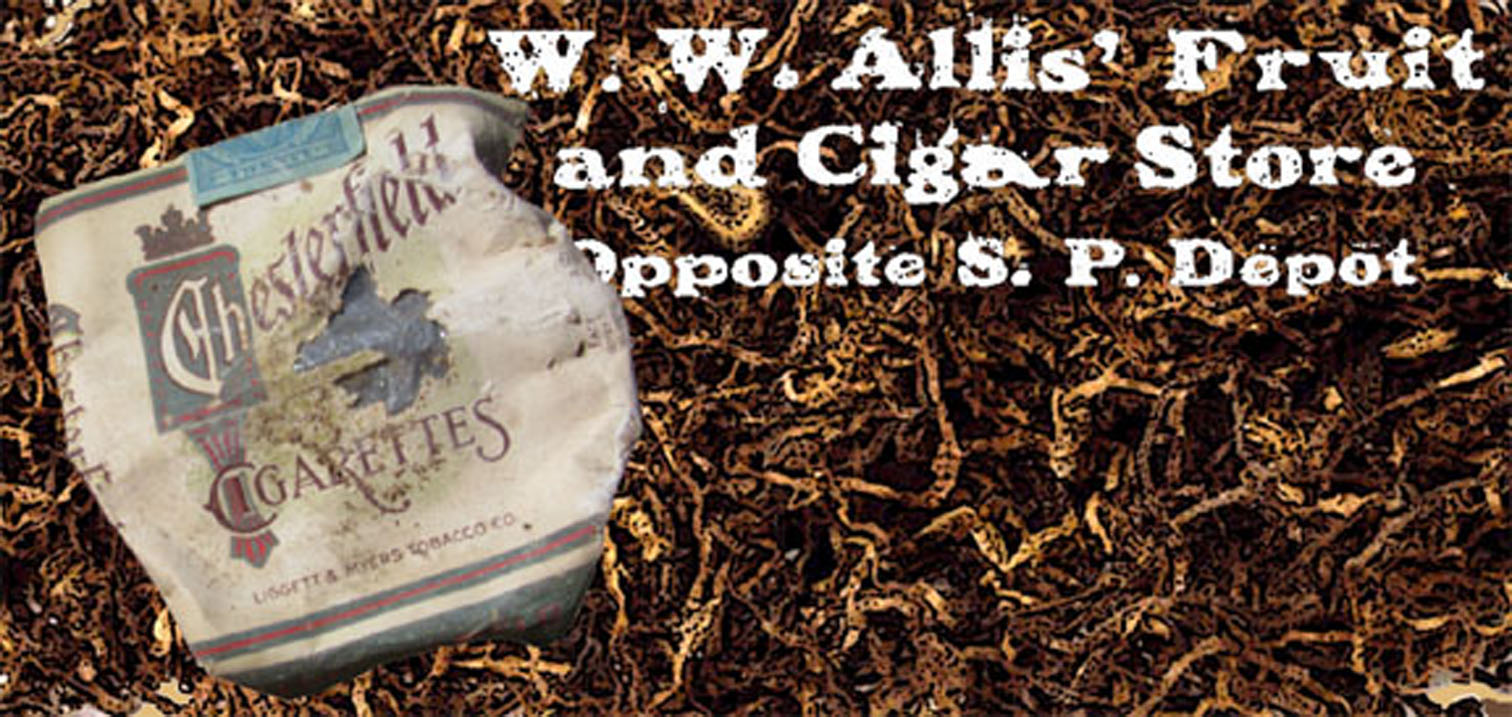
Up in Smoke: A History of Tobacco in Tucson
Desert Archaeology paleoethnobotanist Dr. Michael Diehl joins up with historical archaeologist Homer Thiel to discuss Nicotiana sp. and its use through time in southern Arizona.
In January 1964, Smoking and Health: Report of the Advisory Committee to the Surgeon General of the United States shocked American citizens by documenting the deleterious effects of smoking tobacco. In the years since, public health campaigns have helped reduce the number of people who use tobacco products. But how was tobacco used in the past? Desert Archaeology’s research has documented the history of tobacco stretching back thousands of years in the Sonoran Desert.
Tobacco used in modern cigarettes, cigars, and pipes is a highly altered domesticated plant from the same family of plants—Solanaceae—that includes such staples as tomatoes and potatoes, and such poisons as nightshade. Modern smoking tobacco (Nicotiana tabacum) was domesticated in the prehistoric Andes and diffused to North America, where colonizing Europeans took up the habit of smoking after encountering Native Americans who used the plant recreationally and ceremonially.
The wild tobaccos are no plants to mess with. Smoked or chewed in small amounts by those who can identify which plant to use and how to use it, coyote tobacco (Nicotiana attenuata) may be hallucinogenic, and was once used in folk medicine to help alleviate pain. The leaves of tree tobacco (Nicotiana glauca) and desert tobacco (Nicotiana trigonphylla), however, contain anabasine, a close chemical relative of nicotine. Anabasine is a toxic alkaloid so potent that even one leaf of tree tobacco or desert tobacco can kill humans if ingested or smoked. If you see them in the wild, admire the flowers, and the horn-worm caterpillars that have evolved immunity to the poisons inherent in tobacco plants, but leave the plants alone.
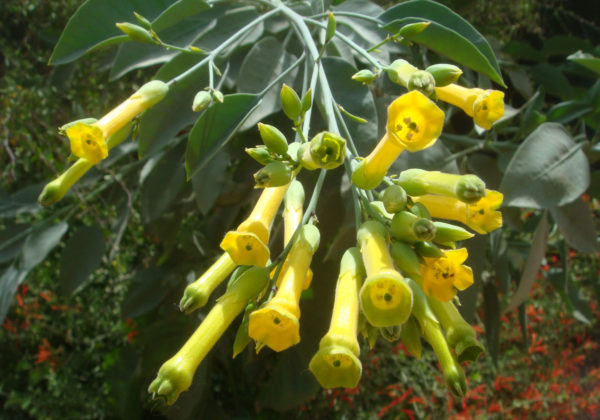
Tree tobacco (Nicotiana glauca). Look but don’t touch.
In Arizona, the earliest evidence of tobacco use takes the form of seeds from wild varieties of tobacco that grow wild throughout Arizona to this day. The evidence includes seeds from quids recovered from Antelope Cave Arizona and identified by Karen Adams as Nicotiana attenuata, and seeds identified as Nicotiana sp. by Dr. Diehl from four Early Agricultural period sites (1200 B.C.-A.D 150) near Tucson. Desert Archaeology has conducted several excavations at one of these sites, Las Capas, located near Interstate 10 and Ina Road at the Pima County Wastewater Plant. Among the artifacts from the site analyzed by Dr. Jenny Adams were fired-clay and stone pipes dating to the San Pedro phase (1200-800 BC). These are the oldest known smoking pipes found in the Tucson Basin.
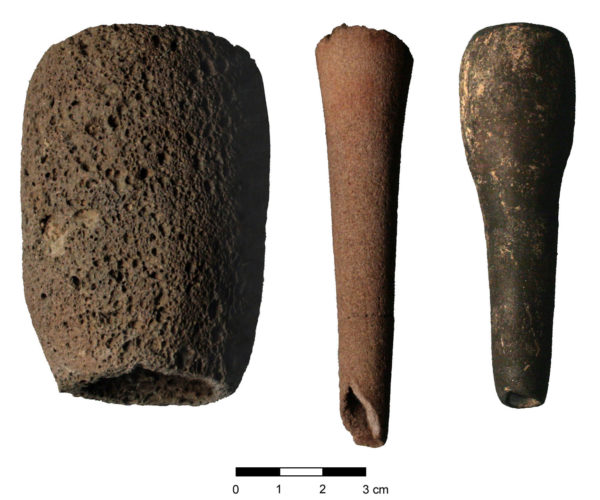
Three pipes from Las Capas: an unfinished vesicular pipe bowl, a self-stemmed stone pipe broken below its bowl, and a fired-clay pipe, all dating to the San Pedro phase (photograph by Robert Ciaccio).
Tobacco was burned in the pipe bowls and the smoke was inhaled by sucking it through the pipe stem.
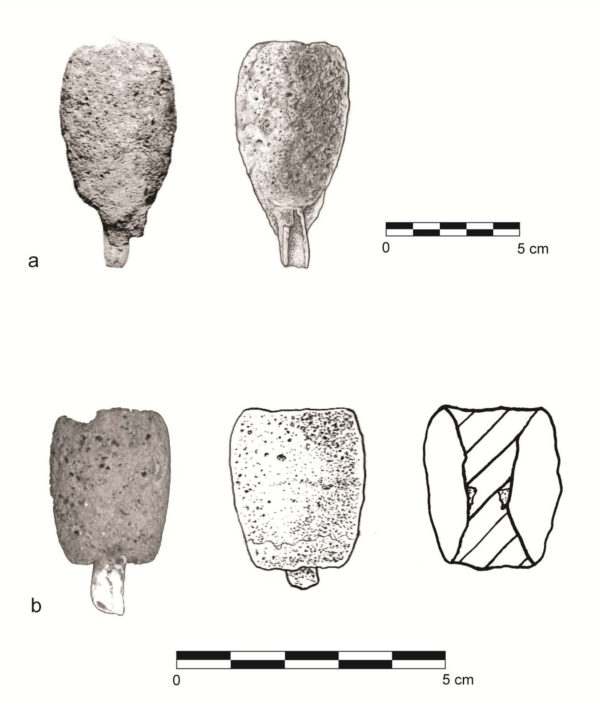
A pair of stone pipes with bone stems from a late San Pedro phase pit at Las Capas (photograph and drawings by Robert Ciaccio).
Dr. Adams worked with traditional technologist Allen Denoyer to create replica stone and fired clay pipes. They recorded the tools used to make new pipes, the techniques utilized, and the length of time it took to create each pipe.
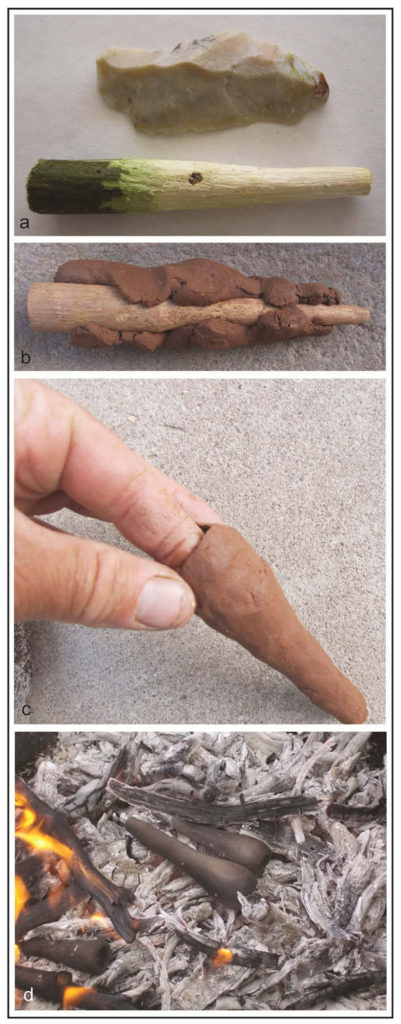
Manufacturing process for two replicas of fired-clay pipes from Las Capas: (a) flake and green mesquite stick used as a mold; (b) clay partially wrapped around the mold; (c) final shaping after the mold was pulled out; (d) replicated pipes firing in coals.
Pipes remained in use into the Early Ceramic period (A.D. 50 to 550). Early ethnographers in the American Southwest reported that pipe smoking was both a social activity and something that happened during rituals. It is likely that the pipes used during the Early Agricultural and Early Ceramic period saw similar uses.
Pipes are not found at Hohokam sites. However tobacco use continued. Reed cigarettes have been found at dry cave sites. These were created by cutting a section of reed where its jointed segments met, where a natural wall extended across the interior of the segment. A small hole was drilled through this wall. One side was filled with tobacco, which was lit, and the smoke sucked through the other end. Last year a collection of 16 reed cigarettes was donated to Desert Archaeology. Unfortunately, we do not know where the items came from, one of the problems created by anonymous collections.
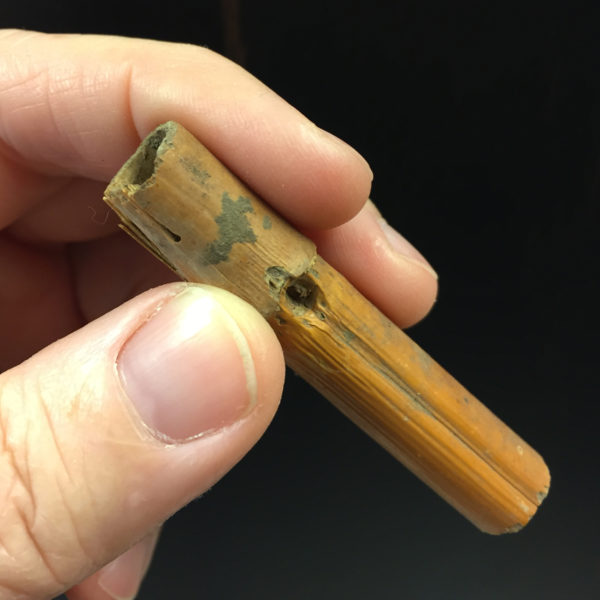
A probable Hohokam-era reed cigarette, part of a collection donated to Desert Archaeology (photograph by R.J. Sliva).
Jumping forward to the Presidio era (1776-1856) in Tucson, smoking tobacco was purchased by the soldiers and civilians living at the adobe-walled fortress in Arizpe, about 150 miles to the southeast of Tucson, and carried back in pack trains or freight wagons. The leaves were rolled up to create cigarettes and cigars. A document from 1804 reveals that residents of Tucson paid 2,210 pesos in tobacco taxes, and that “The tobacco is sold either in the company store or directly by the paymaster.”
When the soldiers evacuated Tucson in 1856 they took the community’s church, civil, and military records with them. At least one soldier claimed afterward that his fellow soldiers tore up the church record books for use as rolling papers for cigarettes. Whether this actually occurred is unknown; however, the records have never been seen since.
Solomon Warner was the first Anglo trader to bring goods into the community, in early 1855. It is likely that he brought tobacco and clay pipes with him. He would later sell cigars for 25 cents each at his saloon. Up until the railroad arrival in 1880, freight wagons carried every imaginable item to Tucson, overland from San Diego, Guaymas, and Santa Fe. The first issue of the first newspaper published in 1858 in Arizona included an advertisement for “Tobacco, of all Sorts and Qualities.”
Cigarettes and cigars continued to be popular among Tucson residents. A small number of people preferred to use pipes for smoking tobacco. Work by Statistical Research, Inc., at the National Cemetery (today called the Alameda-Stone Cemetery), conducted prior to the construction of the Pima County Joint Courts Complex, resulted in the excavation of over 1,000 burials dating from the mid-1850s to 1875. Bioarchaeologists who specialized in human teeth examined the dentitions of every individual. They found ten adults who had crescent-shaped wear marks on their teeth, a result of clenching abrasive clay pipe stems between their teeth. One Hispanic male also had brown stains on his teeth, apparently from cigarettes or chewing tobacco.
Cigarettes and cigars continued to be popular, as seen by a cigarette package found beneath the floor of the Siqueiros-Jácome House on Block 181, today the Presidio San Agustin del Tucson Museum. Soledad Jácome and her family occupied the house between 1866 and 1911.
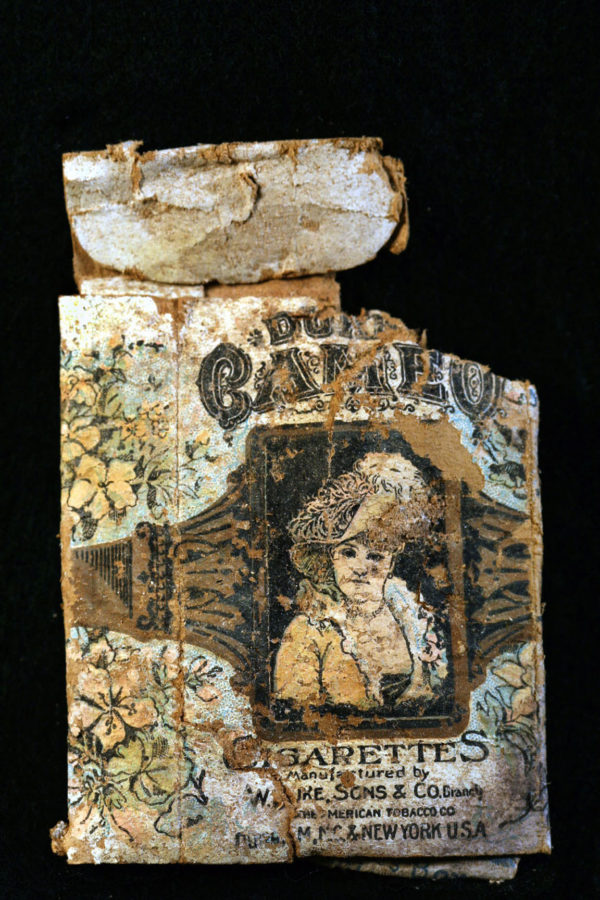
A Duke’s Cameo cigarette package found in the dirt beneath the north room of the Siqueiros-Jácome house in downtown Tucson (photograph by Robert Ciaccio).
Desert Archaeology conducted excavations at the house prior to restoration and construction work, and found several pipes discarded in the backyard. We don’t know whether Soledad smoked tobacco, or whether the smoker was one of the individuals she rented rooms to.
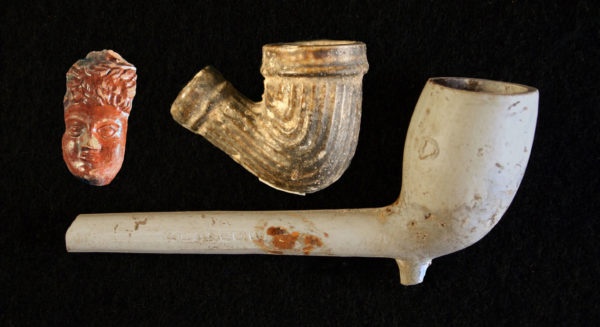
Three ceramic pipes found in the backyard of the Siquerios-Jácome House. One has a molded face, a second originally had a wooden stem, and a third is the classic kaolin clay pipe (photograph by Robert Ciaccio).
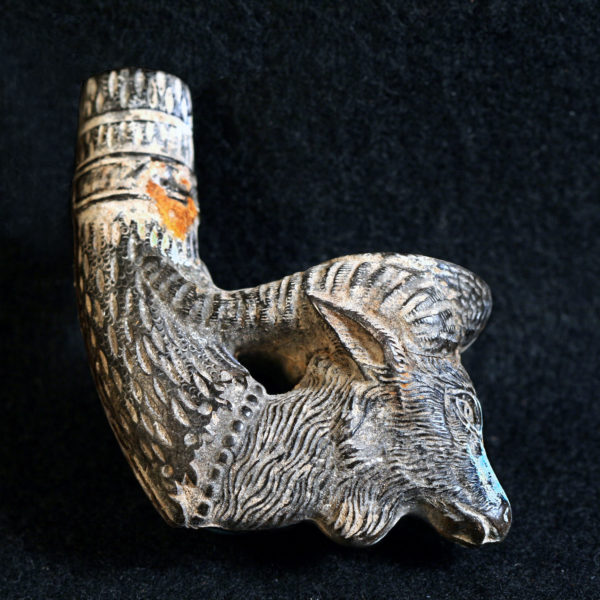
A hard rubber pipe bowl in the shape of a ram’s head found at the Siqueiros-Jácome House (photograph by Robert Ciaccio).
Other substances could be smoked. We occasionally find Chinese opium pipe bowls in downtown Tucson. The Chinese immigrants who arrived in Tucson, beginning in the mid-1870s, brought with them the recreational use of opium. The distinctive ceramic bowls and usually found in association with other Chinese artifacts. City politicians feared the spread of opium use in the community, and a month prior to the arrival of the Southern Pacific Railroad, banned opium “dens” with Ordinance No. 23. Opium use was legal in the Territory until 1913, when an “Offenses Against Good Morals” law was passed by the State Legislature.
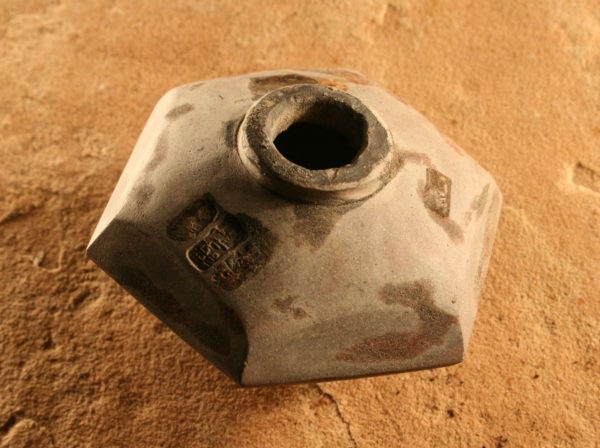
A Chinese opium pipe bowl found on Block 83 in downtown Tucson, discarded by Chinese laundry workers (photograph by Robert Ciaccio).
Today smoking is banned in businesses and government buildings. However, future archaeologists will likely find cigarette butts and vaping devices and will use documentary sources to discuss the history of tobacco use during the 21st century.


